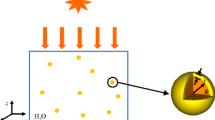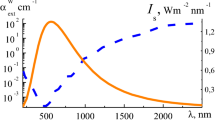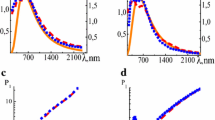Abstract
In this paper, the model for the electromagnetic response of core-satellite nanoparticles is constructed based on finite element method; the quantum corrections are considered for small-sized satellite nanoparticles by introducing Feibelman d parameters in the boundary conditions of electromagnetic theory. Then, the influences of material, size, and structure on the radiant absorption of core-satellite nanoparticles is simulated by the model. The results indicate that the plasmonic coupling between nanoparticles leads to a tunable red-shifted absorption peak with a broadened absorption range, which is primarily controlled by the size of satellite nanoparticles. Based on the analysis of single nanoparticle, the temperature rise and photothermal conversion efficiency of direct absorption solar collectors (DASC) using Au nanofluid and Au/Au core-satellite nanofluid are compared under different conditions. The Au/Au nanofluid with a thickness of 2.0 cm and a volume fraction of 0.005% can capture 97.7% of the solar radiation energy in the wavelength range of 300–1200 nm. The efficiency of solar collectors can reach 76.9% under the same conditions, an increase of nearly 15% compared to which based on Au nanofluids. This work provides a feasibility investigation for the application of core-satellite nanoparticles in photothermal conversion.

















Similar content being viewed by others
Data Availability
The datasets analyzed during the current study are available from the corresponding author on reasonable request.
References
Huang J, He Y, Chen M, Wang X (2019) Separating photo-thermal conversion and steam generation process for evaporation enhancement using a solar absorber. Appl Energy 236:244–252
Hayat MB, Ali D, Monyake KC, Alagha L, Ahmed N (2019) Solar energy-a look into power generation, challenges, and a solar-powered future. Int J Energy Res 43:1049–1067
Wang Z, Huang H, Li G, Yan X, Yu Z, Wang K, Wu Y (2021) Advances in engineering perovskite oxides for photochemical and photoelectrochemical water splitting. Appl Phys Rev 8:021320
Gorji TB, Ranjbar A (2016) A numerical and experimental investigation on the performance of a low-flux direct absorption solar collector (DASC) using graphite, magnetite and silver nanofluids. Sol Energy 135:493–505
Chen W, Zou C, Li X, Li L (2017) Experimental investigation of SiC nanofluids for solar distillation system: stability, optical properties and thermal conductivity with saline water-based fluid. Int J Heat Mass Transf 107:264–270
Jia Y, Alva G, Fang G (2019) Development and applications of photovoltaic–thermal systems: a review. Renew Sustain Energy Rev 102:249–265
Kalogirou SA (2004) Solar thermal collectors and applications. Prog Energy Combust Sci 30:231–295
Chen M, He Y, Zhu J, Kim DR (2016) Enhancement of photo-thermal conversion using gold nanofluids with different particle sizes. Energy Convers Manage 112:21–30
Minardi JE, Chuang HN (1975) Performance of a “black” liquid flat-plate solar collector. Sol Energy 17:179–183
Otanicar TP, Phelan PE, Golden JS (2009) Optical properties of liquids for direct absorption solar thermal energy systems. Sol Energy 83:969–977
Choi SU, Eastman JA (1995) Enhancing thermal conductivity of fluids with nanoparticles. Argonne National Lab.(ANL), Argonne, IL (United States) 66:99–105
Kakaç S, Pramuanjaroenkij A (2009) Review of convective heat transfer enhancement with nanofluids. Int J Heat Mass Transf 52:3187–3196
Saidur R, Leong K, Mohammed HA (2011) A review on applications and challenges of nanofluids. Renew Sustain Energy Rev 15:1646–1668
Goel N, Taylor RA, Otanicar T (2020) A review of nanofluid-based direct absorption solar collectors: design considerations and experiments with hybrid PV/Thermal and direct steam generation collectors. Renew Energy 145:903–913
He Y-L, Wang K, Qiu Y, Du B-C, Liang Q, Du S (2019) Review of the solar flux distribution in concentrated solar power: non-uniform features, challenges, and solutions. Appl Therm Eng 149:448–474
Chen M, He Y, Zhu J, Shuai Y, Jiang B, Huang Y (2015) An experimental investigation on sunlight absorption characteristics of silver nanofluids. Sol Energy 115:85–94
Chen M, He Y, Zhu J, Wen D (2016) Investigating the collector efficiency of silver nanofluids based direct absorption solar collectors. Appl Energy 181:65–74
Karami M, Akhavan-Bahabadi M, Delfani S, Raisee M (2015) Experimental investigation of CuO nanofluid-based direct absorption solar collector for residential applications. Renew Sustain Energy Rev 52:793–801
Guo C, Liu C, Jiao S, Wang R, Rao Z (2020) Introducing optical fiber as internal light source into direct absorption solar collector for enhancing photo-thermal conversion performance of MWCNT-H2O nanofluids. Appl Therm Eng 173:115207
Hazra S, Ghosh S, Nandi T (2019) Photo-thermal conversion characteristics of carbon black-ethylene glycol nanofluids for applications in direct absorption solar collectors. Appl Therm Eng 163:114402
Jain PK, Eustis S, El-Sayed MA (2006) Plasmon coupling in nanorod assemblies: optical absorption, discrete dipole approximation simulation, and exciton-coupling model. J Phys Chem B 110:18243–18253
Kuznetsov AI, Miroshnichenko AE, Brongersma ML, Kivshar YS, Luk’yanchuk B (2016) Optically resonant dielectric nanostructures. Science 354:aag2472
Rativa D, Gómez-Malagón LA (2015) Solar radiation absorption of nanofluids containing metallic nanoellipsoids. Sol Energy 118:419–425
Sosa IO, Noguez C, Barrera RG (2003) Optical properties of metal nanoparticles with arbitrary shapes. J Phys Chem B 107:6269–6275
Zuloaga J, Prodan E, Nordlander P (2010) Quantum plasmonics: optical properties and tunability of metallic nanorods. ACS Nano 4:5269–5276
Wang Z, Zhang ZM, Quan X, Cheng P (2018) A numerical study on effects of surrounding medium, material, and geometry of nanoparticles on solar absorption efficiencies. Int J Heat Mass Transf 116:825–832
Tuersun P, Xe H (2013) Optical absorption analysis and optimization of gold nanoshells. Appl Opt 52:1325–1329
Farooq S, Rativa D, de Araujo RE (2019) Optimizing the sensing performance of SiO2-Au nanoshells. Plasmonics 14:1519–1526
Duan H, Tang L, Zheng Y, Xu C (2018) Effect of plasmonic nanoshell-based nanofluid on efficiency of direct solar thermal collector. Appl Therm Eng 133:188–193
Chen M, He Y, Wang X, Hu Y (2018) Complementary enhanced solar thermal conversion performance of core-shell nanoparticles. Appl Energy 211:735–742
Li H, He Y, Liu Z, Huang Y, Jiang B (2017) Synchronous steam generation and heat collection in a broadband Ag@ TiO2 core–shell nanoparticle-based receiver. Appl Therm Eng 121:617–627
Höller RPM, Dulle M, Thomä S, Mayer M, Steiner AM, Förster S, Fery A, Kuttner C, Chanana M (2016) Protein-assisted assembly of modular 3D plasmonic raspberry-like core/satellite nanoclusters: correlation of structure and optical properties. ACS Nano 10:5740–5750
Kuttner C, Holler RPM, Quintanilla M, Schnepf MJ, Dulle M, Fery A, Liz-Marzan LM (2019) SERS and plasmonic heating efficiency from anisotropic core/satellite superstructures. Nanoscale 11:17655–17663
Gómez-Graña S, Le Beulze A, Treguer-Delapierre M, Mornet S, Duguet E, Grana E, Cloutet E, Hadziioannou G, Leng J, Salmon J-B (2016) Hierarchical self-assembly of a bulk metamaterial enables isotropic magnetic permeability at optical frequencies. Mater Horiz 3:596–601
Yu X, Xuan Y (2018) Investigation on thermo-optical properties of CuO/Ag plasmonic nanofluids. Sol Energy 160:200–207
Zeng J, Xuan Y (2018) Tunable full-spectrum photo-thermal conversion features of magnetic-plasmonic Fe3O4/TiN nanofluid. Nano Energy 51:754–763
Joseph A, Sreekumar S, Kumar CS, Thomas S (2019) Optimisation of thermo-optical properties of SiO2/Ag–CuO nanofluid for direct absorption solar collectors. J Mol Liq 296:111986
Loudon R (2001) The propagation of electromagnetic energy through an absorbing dielectric. J Phys A 3:233
Christensen T, Yan W, Jauho A-P, Soljačić M, Mortensen NA (2017) Quantum corrections in nanoplasmonics: shape, scale, and material. Phys Rev Lett 118:157402
Ding K, Chan CT (2017) Plasmonic modes of polygonal rods calculated using a quantum hydrodynamics method. Phys Rev B 96:125134
Toscano G, Straubel J, Kwiatkowski A, Rockstuhl C, Evers F, Xu H, Asger Mortensen N, Wubs M (2015) Resonance shifts and spill-out effects in self-consistent hydrodynamic nanoplasmonics. Nat Commun 6:1–11
Ciracì C, Hill R, Mock J, Urzhumov Y, Fernández-Domínguez A, Maier S, Pendry J, Chilkoti A, Smith D (2012) Probing the ultimate limits of plasmonic enhancement. Science 337:1072–1074
Ciracì C (2017) Current-dependent potential for nonlocal absorption in quantum hydrodynamic theory. Phys Rev B 95:245434
Khurgin J, Tsai W-Y, Tsai DP, Sun G (2017) Landau damping and limit to field confinement and enhancement in plasmonic dimers. ACS Photonics 4:2871–2880
Yang Y, Zhu D, Yan W, Agarwal A, Zheng M, Joannopoulos JD, Lalanne P, Christensen T, Berggren KK, Soljačić M (2019) A general theoretical and experimental framework for nanoscale electromagnetism. Nature 576:248–252
Echarri AR, Gonçalves P, Tserkezis C, de Abajo FJG, Mortensen NA, Cox JD (2021) Optical response of noble metal nanostructures: quantum surface effects in crystallographic facets. Optica 8:710–721
Feibelman PJ (1982) Surface electromagnetic fields. Prog Surf Sci 12:287–407
Gonçalves P, Christensen T, Rivera N, Jauho A-P, Mortensen NA, Soljačić M (2020) Plasmon–emitter interactions at the nanoscale. Nat Commun 11:1–13
Mishchenko M, Martin P (2013) Peter Waterman and T-matrix methods. J Quant Spectrosc Radiat Transfer 123:2–7
Swinehart DF (1962) The Beer-Lambert law. J Chem Educ 39:333
Luo Z, Wang C, Wei W, Xiao G, Ni M (2014) Performance improvement of a nanofluid solar collector based on direct absorption collection (DAC) concepts. Int J Heat Mass Transf 75:262–271
Taylor RA, Phelan PE, Otanicar TP, Adrian R, Prasher R (2011) Nanofluid optical property characterization: towards efficient direct absorption solar collectors. Nanoscale Res Lett 6:1–11
Hale GM, Querry MR (1973) Optical constants of water in the 200-nm to 200-μm wavelength region. Appl Opt 12:555–563
Tyagi H, Phelan P, Prasher R (2009) Predicted efficiency of a low-temperature nanofluid-based direct absorption solar collector. J Sol Energy Eng 131
Duan H, Tang L, Zheng Y, Xu C (2018) Effect of plasmonic nanoshell-based nanofluid on efficiency of direct solar thermal collector. Appl Therm Eng 188–193
Jeon J, Park S, Lee BJ (2016) Analysis on the performance of a flat-plate volumetric solar collector using blended plasmonic nanofluid. Sol Energy 132:247–256
Kuttner C, Höller RP, Quintanilla M, Schnepf MJ, Dulle M, Fery A, Liz-Marzán LM (2019) SERS and plasmonic heating efficiency from anisotropic core/satellite superstructures. Nanoscale 11:17655–17663
Gellner M, Steinigeweg D, Ichilmann S, Salehi M, Schutz M, Kompe K, Haase M, Schlucker S (2011) 3D self-assembled plasmonic superstructures of gold nanospheres: synthesis and characterization at the single-particle level. Small 7:3445–3451
Han F, Vivekchand SRC, Soeriyadi AH, Zheng Y, Gooding JJ (2018) Thermoresponsive plasmonic core-satellite nanostructures with reversible, temperature sensitive optical properties. Nanoscale 10:4284–4290
Borsley S, Flook S, Kay ER (2015) Rapid and simple preparation of remarkably stable binary nanoparticle planet–satellite assemblies. Chem Commun 51:7812–7815
Zeng J, Xuan Y (2018) Enhanced solar thermal conversion and thermal conduction of MWCNT-SiO2/Ag binary nanofluids. Appl Energy 212:809–819
Wang X, He Y, Chen M, Hu Y (2018) ZnO-Au composite hierarchical particles dispersed oil-based nanofluids for direct absorption solar collectors. Sol Energy Mater Sol Cells 179:185–193
Xie BW, Dong J, Zhao JM, Liu LH (2018) Radiative properties of hedgehog-like ZnO-Au composite particles with applications to photocatalysis. J Quant Spectrosc Radiat Transfer 217:1–12
Zhang J, Jin X, Morales-Guzman PI, Yu X, Liu H, Zhang H, Razzari L, Claverie JP (2016) Engineering the absorption and field enhancement properties of Au–TiO2 nanohybrids via whispering gallery mode resonances for photocatalytic water splitting. ACS Nano 10:4496–4503
Alvarez-Fernandez A, Nallet F, Fontaine P, Cummins C, Hadziioannou G, Barois P, Fleury G, Ponsinet V (2020) Large area Al2O3–Au raspberry-like nanoclusters from iterative block-copolymer self-assembly. RSC Adv 10:41088–41097
Mukha I, Chepurna O, Vityuk N, Khodko A, Storozhuk L, Dzhagan V, Zahn DR, Ntziachristos V, Chmyrov A, Ohulchanskyy TY (2021) Multifunctional magneto-plasmonic Fe3O4/Au nanocomposites: approaching magnetophoretically-enhanced photothermal therapy. Nanomaterials 11:1113
Rossner C, Fery A (2020) Planet–satellite nanostructures from inorganic nanoparticles: from synthesis to emerging applications. MRS Commun 10:112–122
Funding
This work was supported by Natural Science Foundation of China (Grant number 51476078).
Author information
Authors and Affiliations
Contributions
Xiangtian Song: methodology, simulation, writing—original draft. Jiayu Li: conceptualization, methodology, analysis, writing —review. All authors read and approved the final manuscript.
Corresponding author
Ethics declarations
Conflict of Interest
The authors declare no competing interests.
Additional information
Publisher's Note
Springer Nature remains neutral with regard to jurisdictional claims in published maps and institutional affiliations.
Rights and permissions
Springer Nature or its licensor (e.g. a society or other partner) holds exclusive rights to this article under a publishing agreement with the author(s) or other rightsholder(s); author self-archiving of the accepted manuscript version of this article is solely governed by the terms of such publishing agreement and applicable law.
About this article
Cite this article
Song, X., Li, J. Electromagnetic Response of Core-Satellite Nanoparticles for Application in Photothermal Conversion. Plasmonics 18, 661–676 (2023). https://doi.org/10.1007/s11468-023-01787-z
Received:
Accepted:
Published:
Issue Date:
DOI: https://doi.org/10.1007/s11468-023-01787-z




